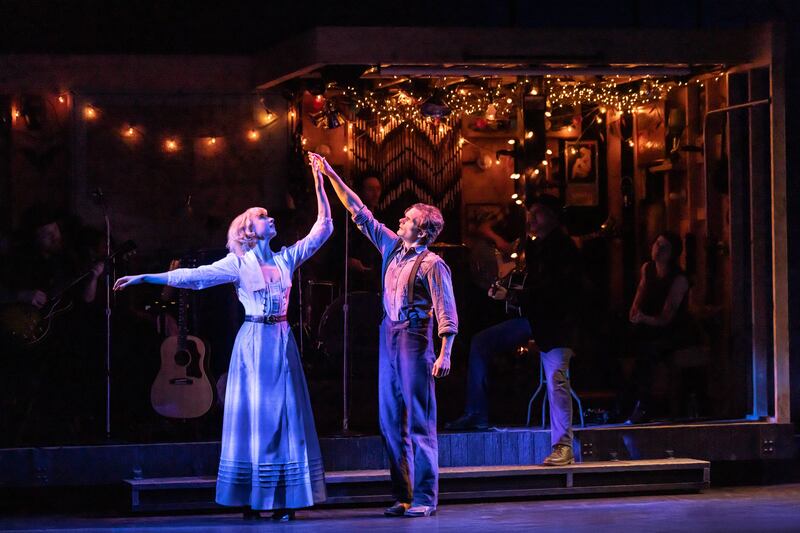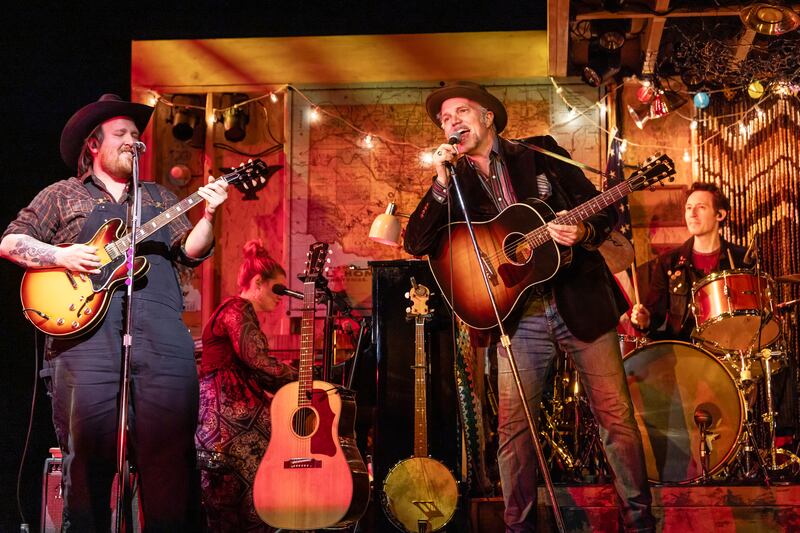When it gets too hot, a splash of cold water is deliciously welcome. And so it is on Broadway at this time of year when a gaggle of shows scramble to open before the stroke of midnight Sunday, the cutoff time to be eligible for this year’s Tony Awards, whose nominations will be announced Thursday.
All the conventional heat comes from celebrities in starring roles, and spectacular shows with big budgets. While there is nothing wrong with well-executed Broadway maximalism, the joy at this time of year is also seeing shows working in a different register, with less bombast and celebrity—still going big but creatively swimming in a different current to the Broadway mainstream.
Oh, Mary! and Maybe Happy Ending are two such shows, and the exceptional Dead Outlaw (Longacre Theatre, booking to July 27) now joins them as a standout singular creation. Its title turns out to be shockingly literal.
This darkly witty musical is directed by David Cromer and conceived by David Yazbek with music and lyrics by Yazbek and Erik Della Penna and a book by Itamar Moses. (Cromer, Moses, and Yazbek all collaborated on the Tony Award-conquering The Band’s Visit.) It tells the wildest of true stories—about a person and America. Last year, it won multiple awards when it premiered off-Broadway.

The Maine-born Elmer McCurdy (Andrew Durand) was an outlaw who was shot and killed in Oklahoma in 1911. However, he wasn’t buried until 1976. For 65 years his dead, then mummified body became variously a tourist attraction, privately owned property, movie promotional tool, then an amusement park piece of decoration—an extreme story told, acted, and sung brilliantly in Dead Outlaw.
While alive, the excellent Durand gives McCurdy both a curdling and violent menace and hapless, pathetic rootlessness. We watch him travel across the heartland getting mixed up in acts of criminality and violence. One extended sequence shows how bad he was at creating dynamite to blow up safes, or even identify the correct train holding the loot he was targeting.
On a mostly unadorned stage, designed by Arnulfo Maldonado and beautifully lit by Heather Gilbert, the principal piece of decoration is a rotating shed with a map of America on its background wall, in which Jeb Brown variously plays the bandleader to a pumped-up onstage orchestra, the show’s beguiling narrator, and a frustrated leader of a group of ne’er-do-wells McCurdy joins for a time (until they throw him out for screwing up so much).

The style of music mirrors the story being told—folk, rock, a loud polyphony of Americana—with Durand flaring into furious song for numbers like “Killed a Man in Maine,” which conveys both his capacity for violence alongside fundamentally also being a loser.
Eddie Cooper, Dashiell Eaves, Julia Knitel, Ken Marks, Trent Saunders, and Thom Sesma play—with malleable aplomb—multiple characters who figure both in McCurdy’s living life and his 65-year period as a corpse being traded and transported around America.
Playing dead—in the show’s most memorable visual—Durand spends extended periods of time lit by a blue-white-ish light as McCurdy’s mummified corpse placed upright in a coffin, staring stock-still out at the audience, holding a gun. Durand achieves this frozen state so convincingly (take an extra bow, make-up designer J. Jared Janas) you wonder if the producers have created an inanimate body double.
Initially we see McCurdy’s first undertaker as a kind of savior, not willing to hand the body over to people falsely claiming to be McCurdy’s family. But soon enough he is using arsenic to preserve the body and charging folks to see it. Then McCurdy’s body is on the move to its epic afterlife of funfairs, wax museums, and private owners. Hucksters, weirdos, and opportunists get out their wallets.
The show lives up to its title; a cadaverously made-up Durand spends just as much time playing McCurdy dead—as an impassive object of trade and a thing ultimately left in a store-cupboard—as he does alive. Playing the daughter of a movie director who buys the corpse at one point, Knitel sings at McCurdy all her teenage heartbreak and trivialities.
You wonder (or rather hope, he’s so good) if Durand will emerge from the coffin to sing something. Nope. A sub-storyline around a long-distance runner—McCurdy’s body used to promote a coast-to-coast race—has a meaning within the show, but acts as an unnecessary drag on the story.
The musical’s key repeated song, “Dead,” as sung by Brown, recites a series of famous names, living and dead, along with “your momma” and others in all our lives, who are dead. It alludes not just to the fate of us all, but that death is the great unifier and equalizer. Whatever we wish for—fame, notoriety, a regular life—we have no control over it.
Sesma, playing Dr. Thomas Noguchi, the well-known LA coroner who presides over McCurdy’s body in the 1970’s, oversees a memorable showstopper, the crooner/big-band strained “Up to the Stars,” which darkly imagines the business of death and fame in Tinseltown, including a waltzing Marilyn Monroe.

“Only in America” seems to be the wry, baseline sentiment of the variously absurd and grotesque beats of McCurdy’s story—a place where a man could fall through all sorts of cracks, change identities, commit crimes, lose everything, die, then become a bought-and-sold, freakish object of fascination, gawped at, prodded, and then forgotten and disregarded, before finally receiving a proper burial 60 years after his death.
And now, over 100 years since he died, McCurdy is the subject of a Broadway musical, where audiences are encouraged to be both horrified and humored by his story. As striking a musical as Dead Outlaw is, and for all a Broadway theater’s fancy surrounds, we’re still really at the funfair gawping at the strange life-in-death of Elmer McCurdy. Only in America.
Hold Me in the Water
Ryan Haddad’s beautifully written, immaculately staged one-person show, Hold Me in the Water (Playwrights Horizons, to May 4) is mostly a story about falling in love, relating what happened when Haddad fell in love with a guy, and then faced heartbreak when the guy finished things four months later.
Haddad, who has cerebral palsy, also uses the show—directed with lovely subtlety by Danny Sharron to match its writing—to interrogate able-bodied people’s attitudes to disability, asking the audience directly if they had ever romanced someone with a disability, and if not, would we.
The guy Haddad fell in love with was a dream boyfriend in respect of emotionally and practically being sensitive to whatever Haddad might need in and out of bed. On a mostly bare stage, with minimal and telling lighting (by Cha See) and sound effects (by Tosin Olufolabi), Haddad conveys the rush of initial feelings, the excitement of first dates, the puzzling over whether the relationship has a future, sexual desire, sex itself, and the inevitable response of a writer to everything when it falls apart—to write it down and craft a charming and pointed stage show out of it.
The post ‘Dead Outlaw’ Is Stunning—and Broadway’s Most Insane Musical appeared first on The Daily Beast.




